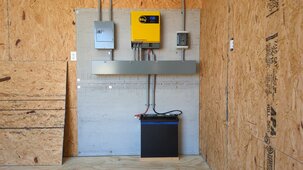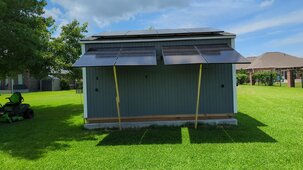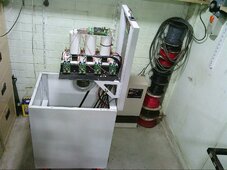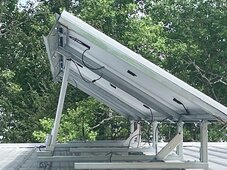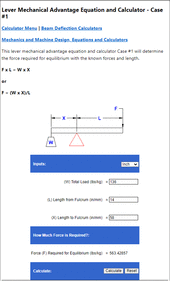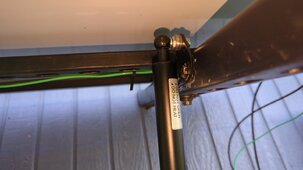Still working on my shed project (off grid, EG4-3K, 8 panels). I have four panels on the roof and four on the back wall, all in a single string of 8, and facing south. The wall mounted panels tend to limit production of the entire string. Since the wall mounted panel assemblies are hinge mounted, I can lift them up with a 2x4, and production goes way up (900watts vs. 2400watts).
Lifting the panels with a 2x4 is difficult, so I'm trying to use gas-struts instead. I've tried three different sets of struts from Amazon and none are working quite right. The first set was way over powered; I couldn't lower the panels. The second set was weak and too short; they ran out of travel. The third set is better, but still not quite right.
Amazon has lots of struts, but the advertised ratings and mountings make it difficult to select the right ones. Using the calculator at gasspringsshop.com gives believable results, but their struts are way expensive ($400+); I replaced the gas struts on my car for $40. And, thier design results were a lot different from most others.
The linked video shows the panels rising up by themselves, but not all the way, I have to push them up a little. Putting them down needs a little more force than I was hoping for, and they don't stay down in-place. I probably have the mount points or something else wrong, but I'm not sure how to solve it. Any suggestions on what to try next?
 drive.google.com
drive.google.com
Lifting the panels with a 2x4 is difficult, so I'm trying to use gas-struts instead. I've tried three different sets of struts from Amazon and none are working quite right. The first set was way over powered; I couldn't lower the panels. The second set was weak and too short; they ran out of travel. The third set is better, but still not quite right.
Amazon has lots of struts, but the advertised ratings and mountings make it difficult to select the right ones. Using the calculator at gasspringsshop.com gives believable results, but their struts are way expensive ($400+); I replaced the gas struts on my car for $40. And, thier design results were a lot different from most others.
The linked video shows the panels rising up by themselves, but not all the way, I have to push them up a little. Putting them down needs a little more force than I was hoping for, and they don't stay down in-place. I probably have the mount points or something else wrong, but I'm not sure how to solve it. Any suggestions on what to try next?
Panels Opening.mp4
 drive.google.com
drive.google.com
Attachments
Last edited:



